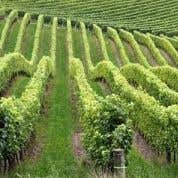Two years since I first wrote about this and other new French appellations, the first wines of the catch-all Coteaux Bourguignons appeared last month. The official decree was published in November 2011.
It replaces the rather less inviting Bourgogne Grand Ordinaire (I never could understand how a wine could be both great and ordinary) and Bourgogne Ordinaire. It even has its own little single-page French website: www.coteauxbourguignons.com, from which this photo comes.
Wines labelled Coteaux Bourguignons may soon be on a shelf near you, particularly if you are in France. They will of course be exported but I wonder if they will be any more visible outside France than the Bourgogne Grand Ordinaire has been. (Notable exceptions include Arnaud Ente's 100% Gamay, lauded in several notes on this site.)
The appellation covers wines made throughout 'greater Burgundy', from the Auxerrois (about as far north as Épineuil, north-east of Chablis) down to and including Beaujolais.
Attentive readers will realise that this is probably the most controversial aspect of the change since some Beaujolais producers may feel the adjective bourguignon (meaning 'from Burgundy') adds greater lustre to their products but it could mislead consumers. There will be no simple way of knowing from the label which 'burgundian slope' supplied the fruit.
Wines may be made from one or more of any of Burgundy's authorised varieties: Aligoté, Chardonnay, Melon, Pinot Blanc and Pinot Gris for whites; for reds, the principal varieties are Gamay, Pinot Noir, César (this last only in the Yonne), and the 'accessory' varieties, which alone or together may contribute no more than 10% of the blend, are Aligoté, Chardonnay, Gamay de Bouze, Gamay de Chaudenay, Melon, Pinot Blanc and Pinot Gris. Rosé wines, which may be labelled Clairet, may be made from the principal varieties Gamay, Pinot Noir and César (Yonne only) and accessory varieties Aligoté, Chardonnay, Melon and Pinot Blanc.
There is also provision for a vin nouveau or vin primeur, along the lines of Beaujolais Nouveau, but for white wines only.
The appellation gives producers a great amount of freedom. It will be interesting to see what they do with it and whether it allows established producers to play with more options and newcomers with typically less sought-after vineyards to make a name for themselves. However, since it has been suggested that the average price of the wines will be between 5 and 7 euros, we probably shouldn't expect too much.
One of the other appellations I mentioned in that article two years ago, Bourgogne Côte d'Or, also anticipated in 2012, seems to be floundering among the committees.

